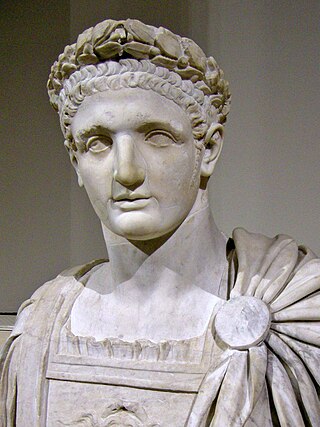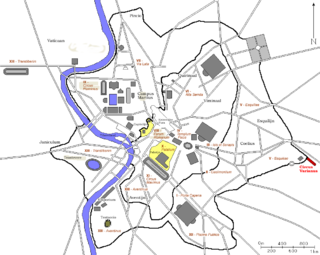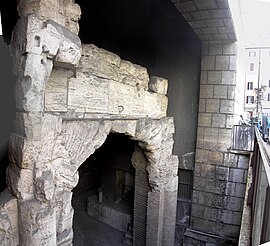History
Construction and design
The Stadium of Domitian was dedicated in AD 86, as part of an Imperial building programme at the Field of Mars, following the damage or destruction of most of its buildings by fire in AD 79. It was Rome's first permanent venue for competitive athletics, erected for Domitian's celebration of the Capitoline Games. It was patterned after Greek stadia and seated approximately 30,000. [1] The substructures and support frames were made of brick and concrete – a robust, fire-retardant and relatively cheap material – clad in marble. Stylistically, the Stadium facades would have resembled those of the Colosseum; the floor plan was a scaled down version of the Circus Maximus, having a similarly semi-circular end. Colini (1943) estimates the total stadium length as approximately 275 metres, and the total width as 106 metres, [2] while later sources give the height of its outer perimeter benches as 30 m (100 ft) above ground level and its inner perimeter benches as 4.5 m (15 ft) above the arena floor. [3] This arrangement offered a clear view of the track from most seats. The typically Greek layout gave the Stadium its Latinised Greek name, in agones (the place or site of the competitions). The flattened end was sealed by two vertically staggered entrance galleries and the perimeter was arcaded beneath the seating levels, with travertine pilasters between its cavea (enclosures). The formation of a continuous arena trackway by a raised "spina" or strip has been conjectured. [4]
The Stadium of Domitian was the northernmost of a series of public buildings on Campus Martius. To its south stood the smaller and more intimate Odeon of Domitian, used for recitals, songs and orations. The southernmost end of the Campus was dominated by the Theater of Pompey, restored by Domitian during the same rebuilding program. [5]
Uses
The Stadium was used almost entirely for athletic contests. For "a few years", following fire damage to the Colosseum in AD 217, it was used for gladiator shows. [6] According to the Historia Augusta's garish account of Emperor Elagabalus, the arcades were used as brothels [7] and the emperor Severus Alexander funded his restoration of the Stadium partly with tax-revenue from the latter. [8] In Christian martyr-legend, St Agnes was put to death there during the reign of the emperor Diocletian, in or near one of its arcades. With the economic and political crises of the later Imperial and post-Imperial eras, the Stadium seems to have fallen out of its former use; the arcades provided living quarters for the poor and the arena a meeting place. It may have been densely populated: "With the decline of the city after the barbarian invasions, the rapidly dwindling population gradually abandoned the surrounding hills and was concentrated in the campus Martius, which contained the main part of Rome until the new developments in the nineteenth century." [9] Substantial portions of the structure survived into the Renaissance era, when they were mined and robbed for building materials.
Legacy
The Piazza Navona sits over the interior arena of the Stadium. The sweep of buildings that embrace the Piazza incorporates the Stadium's original lower arcades. They include the most recent rebuilding of the Church of Sant'Agnese in Agone, first founded in the ninth century at the traditional place of St. Agnes' martyrdom. [10]

The Circus Maximus is an ancient Roman chariot-racing stadium and mass entertainment venue in Rome, Italy. In the valley between the Aventine and Palatine hills, it was the first and largest stadium in ancient Rome and its later Empire. It measured 621 m (2,037 ft) in length and 118 m (387 ft) in width and could accommodate over 150,000 spectators. In its fully developed form, it became the model for circuses throughout the Roman Empire. The site is now a public park.

The Colosseum is an elliptical amphitheatre in the centre of the city of Rome, Italy, just east of the Roman Forum. It is the largest ancient amphitheatre ever built, and is still the largest standing amphitheatre in the world, despite its age. Construction began under the emperor Vespasian in 72 and was completed in 80 AD under his successor and heir, Titus. Further modifications were made during the reign of Domitian. The three emperors who were patrons of the work are known as the Flavian dynasty, and the amphitheatre was named the Flavian Amphitheatre by later classicists and archaeologists for its association with their family name (Flavius).

The Campus Martius was a publicly owned area of ancient Rome about 2 square kilometres in extent. In the Middle Ages, it was the most populous area of Rome. The IV rione of Rome, Campo Marzio, which covers a smaller section of the original area, bears the same name.

The naumachia in the Ancient Roman world referred to both the staging of naval battles as mass entertainment, and the basin or building in which this took place.

The Circus Flaminius was a large, circular area in ancient Rome, located in the southern end of the Campus Martius near the Tiber River. It contained a small race-track used for obscure games, and various other buildings and monuments. It was "built", or sectioned off, by Gaius Flaminius in 221 BC. After Augustus divided the city into 14 administrative regions, the Circus Flaminius gave its name to Regio IX, which encompassed the Circus and all of the Campus Martius west of the Via Lata.

The Theatre of Pompey was a structure in Ancient Rome built during the latter part of the Roman Republican era by Pompey the Great. Completed in 55 BC, it was the first permanent theatre to be built in Rome. Its ruins are located at Largo di Torre Argentina.

In Ancient Rome, the Capitoline Games were annual games (ludi). They started out as religious holiday celebrations that "called upon divine support to ensure continued prosperity for the state." They were instituted by Camillus, 387 BC, in honor of Jupiter Capitolinus, and in commemoration of the Capitol's not being taken by the Gauls that same year. The games lasted sixteen days, starting on October 15.

The Ludus Magnus was the largest of the gladiatorial schools in Rome. It was built by the emperor Domitian in the late first century C.E., alongside other building projects undertaken by him such as three other gladiatorial schools across the Roman Empire. The training school is situated directly east of the Colosseum in the valley between the Esquiline and the Caelian hills, an area already occupied by Republican and Augustan structures. While there are remains that are visible today, they belong to a reconstruction that took place under the emperor Trajan where the Ludus plane was raised by about 1.5 metres. The Ludus Magnus was essentially a gladiatorial arena where gladiators from across the Roman Empire would live, eat, and practice while undergoing gladiatorial training in preparation for fighting at the gladiatorial games held at the Colosseum.

The Amphitheatre of Statilius Taurus was an Roman amphitheatre in ancient Rome. The amphitheatre was inaugurated in 29 BC. Earlier arenas were temporary structures that were disassembled after the event. The amphitheatre was built by Titus Statilius Taurus, who paid for it from his own resources. Statilius Taurus was a successful general and politician in the time of emperor Augustus and had gathered much wealth during his career. For the inauguration he also paid for the gladiatorial games.

The Domus Augustana is the modern name given to the central residential part of the vast Roman Palace of Domitian on the Palatine Hill. In antiquity the name may have applied to the whole of the palace.

Jupiter Tonans, or, in Latin spelling, ivppiter tonans was the aspect (numen) of Jupiter venerated in the Temple of Jupiter Tonans, which was vowed in 26 BCE by Augustus and dedicated in 22 BCE on the Capitoline Hill; the Emperor had narrowly escaped being struck by lightning during the campaign in Cantabria. An old temple in the Campus Martius had long been dedicated to Iuppiter Fulgens. The original cult image installed in the sanctuary by its founder was by Leochares, a Greek sculptor of the 4th century BCE.

The Odeon of Domitian was an ancient Roman building on the Campus Martius in Rome, used for plays and musical competitions and with room for an audience of 11,000. The first Odeum, at Rome, was built by Domitian in imitation of Greek odeons. It was completed or restored in 106 by Apollodorus of Damascus. The outline of its cavea is still preserved by the façade of the Palazzo Massimo alle Colonne, but the only actual remains is a cipoline monolithic column just in front of the Palazzo's rear façade.

The Trigarium was an equestrian training ground in the northwest corner of the Campus Martius in ancient Rome. Its name was taken from the triga, a three-horse chariot.

Circus Varianus was a large Roman circus, started during the reign of Caracalla and located in the palatial villa complex known as the Horti Spei Veteris, which included the Amphitheatrum Castrense. This circus was where Elagabalus raced chariots under the family name of Varius, giving the site its name. The circus was later restructured by Elagabalus, who removed the western end to create more space for the palace by moving the starting gates (carcares) back and building two towers at the end.

The Palace of Domitian was built as Roman emperor Domitian's official residence in 81–92 AD and was used as such by subsequent emperors. Its remains sit atop and dominate the Palatine Hill in Rome, alongside other palaces.

The Baths of Nero or Baths of Alexander were a complex of ancient Roman baths on the Campus Martius in Rome, built by Nero in either 62 or 64 and rebuilt by Alexander Severus in 227 or 229. It stood between the Pantheon and the Stadium of Domitian and were listed among the most notable buildings in the city by Roman authors and became a much-frequented venue. These thermae were the second large public baths built in Rome, after the Baths of Agrippa, and it was probably the first "imperial-type" complex of baths, with a monumental scale and symmetrical, axially-planned design. While in the sixteenth century the foundations of the caldarium were still visible, nothing else of the structure remains above ground except some fragments of walls incorporated into the structure of Palazzo Madama.

Flavian art is the artistic production of the Roman Empire during the Flavian dynasty from 69 to 96 AD.

The Regio IX Circus Flaminius is the ninth regio of imperial Rome, under Augustus's administrative reform. Regio IX took its name from the racecourse located in the southern end of the Campus Martius, close to Tiber Island.

The Regio X Palatium is the tenth regio of imperial Rome, under Augustus's administrative reform. Regio X took its name from the Palatine Hill and the imperial palaces located on it.

The Domus Tiberiana was an Imperial Roman palace in ancient Rome, located on the northwest corner of the Palatine Hill. It probably takes its name from a house built by the Emperor Tiberius, who is known to have lived on the Palatine, though no sources mention his having built a residence. It was enlarged by the successors to Tiberius, and would have been the principal Roman residence of Tiberius, Caligula, Claudius, and Nero during the early part of his reign. Relatively little is known of the structure archaeologically, since the Farnese Gardens have occupied the site of the main level since the 16th century, making excavation difficult.





















